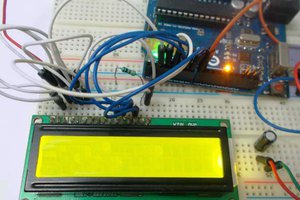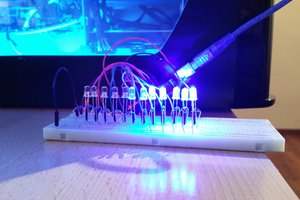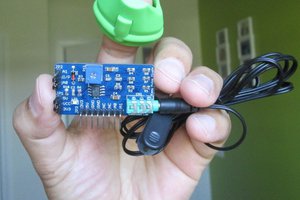To convert analog guitar signal to a digital signal, it needs to be fed into the Arduino's Analog-to-Digitial converter as a signal between 0 and 5 volts. The electric guitar roughly emits a signal between -1 and 1 volts. The OP Amp amplifies the signal to have a peak-to-peak range of 5 volts. The amplification of the OP Amp is controlled by the 10k Potentiometer. Offsetting the signal to oscillate around 2.5 volts is accomplished by wiring the output of the OP Amp to a capacitor that feeds into a voltage divider. This voltage divider has a voltage of 2.5 since the input voltage is 5 volts from the capacitor. The capacitor translates the wave to oscillate around the 2.5 voltage created by the voltage divider.
The signal fed into the Arduino is then analyzed by the Fast Hartley Transform and placed into the correct frequency buckets. The FHT algorithm is implemented as an Arduino library by Open Music Labs. After receiving the coefficients for each frequency range bucket, my Arduino project outputs the results to the LED Matrix. The LED Matrix (with Backpack) is controlled via the LED Backpack Library and the GFX Library, both of which are developed by Adafruit Industries.
 Will Markley
Will Markley
 hIOTron
hIOTron

 Rajendra Bhatt
Rajendra Bhatt
 Nick Johnson
Nick Johnson